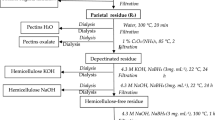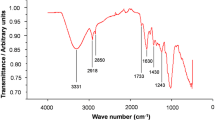Abstract
Present research has delineated the biosorption potential of three different nonliving biomasses namely eucalyptus bark saw dust, mango bark saw dust, and pineapple fruit peel with respect to Zn (II) ion removal from liquid phase through batch experiments. The efficacy of Zn (II) ion biosorption onto surface of biosorbents was judged and correlated with biosorbent particle size, surface chemistry, and surface texture. Maximum metal ion uptake capacity, percentage removal, and minimum equilibrium concentration as 1.688 mg/g, 84.4%, and 1.56 mg/l, respectively, was obtained using eucalyptus bark saw dust mediated biosorption followed by mango bark saw dust as 1.028 mg/g, 51.4%, and 4.867 mg/l and pineapple fruit peel as 0.45 mg/g, 22.9%, and 7.71 mg/l, respectively, at a particle size of 0.5 mm. Additionally, present investigation also proved that biosorption efficiency and metal ion interaction with adsorbent surface also depends upon presence of functional groups involved in metal ion adsorption and surface porosity.









Similar content being viewed by others
References
Agouborde, L., & Navia, R. (2009). Heavy metals retention capacity of a non conventional sorbent developed from a mixture of industrial and agricultural waste. Journal of Hazardous Materials. doi:10.1016/j.jhazmat.2009.10.027.
Akar, S. T., Yetimoglu, Y., & Gedikbey, T. (2009). Removal of chromium (VI) ions from aqueous solutions by using Turkish montmorilloinite clay: effect of activation and modification. Desalination, 244, 97–108.
Arshad, M., Zafar, N. M., Younis, S., & Nadeem, R. (2008). The use Neem biomass for the biosorption of zinc from aqueous solution. Journal of Hazardous Materials, 157, 534–540.
Arslanoglu, H., Altundogan, S. H., & Tumen, F. (2008). Heavy metal binding properties of esterified lemon. Journal of Hazardous Materials. doi:10.1016/j.jhazmat.2008.09.054.
Bansal, C. R., & Goyal, M. (2005). Activated carbon adsorption. Boca Raton: CRC.
Basha, S., Murthy, Z. P. V., & Jha, B. (2009). Sorption of Hg (II) onto Carica Papaya: Experimental studies and designs of batch sorber. Chemical Engineering Journal, 147, 226–234.
Chand, R., Narimura, K., Kawakita, H., Ohto, K., Watari, T., & Inoue, K. (2009). Grape waste as a biosorbent for removing Cr (VI) from aqueous solution. Journal of Hazardous Materials, 163, 243–250.
Chubar, N., Carvalho, J. R., & Correia, M. J. N. (2004). Heavy metals biosorption on cork biomass: Effect of the pretreatment. Colloids and Surface A: Physiochemical Engineers Aspects, 238, 51–58.
Cimino, G., Passerini, A., & Toscano, G. (2000). Removal of toxic cations and Cr (VI) from aqueous solution by hazelnut. Water Research, 34, 2955–2962.
Dang, H. B. V., Doan, D. H., Dang–Vu, T., & Lohi, A. (2009). Equilibrium and kinetics of biosorption of cadmium (II) and copper (II) ions by wheat straw. Bioresource Technology, 100, 211–219.
Das, K. S., & Guha, A. K. (2009). Biosorption of hexavalent chromium by Termitomyces clypeatus biomass: Kinetics and transmission electron microscopic study. Journal of Hazardous Materials. doi:10.1016/j.jhazmat.2009.01.037.
Demirbas, E., Dizge, N., Sulak, M. T., & Kobya, M. (2008). Adsorption kinetics and equilibrium of copper from aqueous solutions using hazelnut shell activated carbon. Chemical Engineering Journal. doi:10.1016/j.cej.2008.09.027.
Fan, T., Liu, Y., Feng, B., Zeng, G., Yang, C., Zhou, M., et al. (2008). Biosorption of cadmium (II), zinc (II) and lead (II) by Penicillium simplicissimum: Isotherms, kinetics and thermodynamics. Journal of Hazardous Materials, 160, 655–661.
Febrianto, J., Kosasih, N. A., Sunarso, J., Ju, H. Y., Indraswati, N., & Ismadji, S. (2009). Equilibrium and kinetic studies in adsorption of heavy metals using biosorbent: A summary of recent studies. Journal of Hazardous Materials, 162, 616–645.
Gupta, V. K., & Rastogi, A. (2009). Biosorption of hexavalent chromium by raw and acid treated green alga Oedogonium hatei from aqueous solutions. Journal of Hazardous Materials, 163, 396–402.
Kaczala, F., Marques, M., & Hogland, W. (2009). Lead and vanadium removal from real industrial waste water by gravitational setteling /sedimentation on to Pinus slyvestris saw dust. Bioresource Technology, 100, 235–243.
Khambhaty, Y., Mody, K., Basha, S., & Jha, B. (2009). Kinetic, equilibrium and thermodynamic studies on biosorption of hexavalent chromium by dead fungal biomass of marine Aspergillus niger. Chemical Engineering Journal, 145, 489–495.
Khatter, J. I. S., & Shailza. (2009). Optimization of Cd2+ removal by the cyano bacterium Synechocystis pevalekii using the response surface methodology. Process Biochemistry, 44, 118–121.
King, P., Rakesh, N., Lahari, B. S., Kumar, P. Y., & Prasad, V. S. R. K. (2008). Biosorption of zinc onto Syzygicum cumini L.: Equilibrium and kinetic studies. Chemical Engineering Journal, 144, 181–187.
Klein, C. J. (2000). Zinc supplementation. Journal of American Diet Association, 100, 1137–1138.
Lesmana, O. S., Febriana, N., Soetaredjo, E. F., Jaka, S., & Ismadji, S. (2009). Studies on potential application of biomass for the separation of heavy metals from water and waste water. Biochemical Engineering Journal, 44, 19–41.
Liu, Z., & Zhang, F. S. (2009). Removal of lead from waste water using biochars prepared from hydrothermal liquefactions of biomass. Journal of Hazardous Materials. doi:1016/j.jhazmat.2009.01.085.
Lodi, A., Solisio, C., Converti, A., & Borghi, D. M. (1998). Cadmium, zinc, copper, silver, chromium (III) removal from wastewaters by Sphaerotilus natans. Bioprocess Engineering, 19, 197–203.
Marin, P. B. A., Orunto, J. F., Aguilar, M. I., Mesguer, V. F., Saez, J., & Liorens, M. (2009). Use of chemical modification to determine the binding of Cd (II), Zn (II) and Cr (III) ions by orange waste. Biochemical Engineering Journal. doi:10.1016/j.bej.2008.12.010.
Mohan, D., & Singh, P. K. (2002). Single and multi component adsorption of cadmium and zinc using activated carbon derived from bagasse—An agriculture waste. Water Research, 36, 2304–2318.
Nadeem, R., Ansari, T. M., Akhtar, K., & Khalid, A. M. (2009). Pb (II) sorption by pyrolysed Pongamia pinnata pods carbon (PPPC). Chemical Engineering Journal, 152, 54–63.
Nagh, W. S. W., & Hanafih, M. A. K. M. (2008). Removal of heavy metal ions from plant waste by chemically modified plant wastes as adsorbents: A review. Bioresource Technology, 99, 3935–3948.
Naiya, K. T., Choudhray, P., Bhattacharaya, K. A., & Das, K. S. (2009). Sawdust and neembark as low cost natural biosorbent for adsorptive removal of Zn (II) and Cd (II) ions from aqueous solutions. Chemical Engineering Journal, 148, 68–79.
Norton, L., Baskaran, K., & McKenzie, T. (2004). Biosorption of zinc from aqueous solutions using biosolids. Advances in Environmental Research, 8, 629–635.
Nuhoglu, Y., & Malkoc, E. (2009). Thermodynamic and kinetic studies for environmentally friendly Ni (II) biosorption using waste pomace of olive oil factory. Bioresource Technology, 100, 2375–2380.
Ozcan, S. A., Tunali, S., Akar, T., & Ozacan, A. (2009). Biosorption of lead (II) ions onto waste biomass of Phaseouls vulgaris L.: Estimation of the equilibrium, kinetic and thermodynamic parameters. Desalination, 244, 188–198.
Ozdemir, S., Kilinc, E., Poli, A., Nicolus, B., & Guen, K. (2008). Biosorption of Cd, Cu, Ni, Mn and Zn from aqueous solutions by thermophillic bacteria, Geobacillus toebii sub.sp. decanicus and Geobacillus thermoleovorans sbu.sp. strombolensis: Equilibrium, kinetic and thermodynamic studies. Chemical Engineering Journal. doi:10.10.1016/jcej.2009.04.041.
Ozdes, D., Gundogdu, A., Kemer, B., Celal, D., Hasan, B. S., & Soylak, M. (2009). Removal of Pb (II) ions from aqueous solution by waste mud from copper mine industry: Equilibrium, kinetic and thermodynamic study. Journal of Hazardous Materials. doi:10.1016/j.jhazmat.2008.12.073.
Park, Y. J., Ko, J. J., Yun, S. L., Lee, E. Y., Kim, S. J., Kang-Lee, B. C., et al. (2008). Enhancement of bioremediation by Ralstonia sp. HM -1 in sediment polluted by Cd and Zn. Bioresource Technology, 99, 7458–7463.
Riaz, M., Nadeem, R., Hanif, A. M., Ansari, T. M., & Rehman, U. K. (2009). Pb (II) biosorption from hazardous aqueous streams using Gossypium hirusutum (cotton) waste biomass. Journal of Hazardous Materials, 161, 88–94.
Rocha, C. G., Zaia, D. A. M., Alfaya, R. V. S., & Alfaya, A. A. S. (2009). Use of rice straw as biosorbent for removal of Cu (II), Zn (II), Cd (II) and hg (II) ions in industrial effluents. Journal of Hazardous Materials. doi:10.1016/j.jhazmat.2008.11.074.
Roney, N., Smith, V., Cassandra, Williams, M., Osier, M., Paikoff, S. J. (2005). Toxicological profile of zinc. Agency for Toxicology and Disease Registry.
Ruthven, M. D. (1984). Principles of adsorption and adsorption processes. New York: Wiley.
Sari, A., & Tuzen, M. (2009). Kinetic and equilibrium studies of biosorption of Pb (II) and Cd (II) from aqueous solution by macrofungus (Amanita rubescens) biomass. Journal of Hazardous Materials, 164, 1004–1011.
Sengil, A. I., & Ozacar, M. (2009). Competitive biosorption of Pb2+, Cu2+ and Zn2+ ions from aqueous solutions onto valonia tannin resin. Journal of Hazardous Materials. doi:10.1016/j.jhazmat.2008.12.071.
Shek, H. T., Ma, A., Lee, V. K. C., & McKay, G. (2009). Kinetics of zinc ions removal from effluents using ion exchange resin. Chemical Engineering Journal, 146, 63–70.
Shen, W., Chen, S., Shi, S., Li, X., Zhang, X., Hu, W., et al. (2009). Adsorption of Cu (II) and Pb (II) onto diethylenetriamine-bacterial cellulose. Carbohydrate Polymers, 75, 110–114.
Shesha, R. R. (2007). Sorption behavior of Zn (II) ions on synthesized hydroxyapatites. Journal of Colloid and Interface Science, 310, 18–26.
Simon, H. B., Wbbertaman, A., Wanger, D., Tomaska, L., Malcolm, H. (2001). Environmental health criteria, Zinc, World Health Organization, Geneva.
Suksabye, P., Nakajima, A., Paitip, T., Baba, Y., & Nakbanpote, W. (2009). Mechanism of Cr (VI) adsorption by coir pith studied by ESR and adsorption kinetic. Journal of Hazardous Materials, 161, 1103–1108.
Tofan, L., Paduraru, C., Bilba, D., & Rotariu, M. (2008). Thermal power plants ash as sorbent removal of Cu (II) and Zn (II) ions from waste waters. Journal of Hazardous Materials, 156, 1–8.
Treybal, E. R. (1981) Adsorption and ion exchange. In: J. J. Carberry, J. R. Flair, M. S. Peters, W. R. Schowalter, J. Wei (Eds.), Mass transfer operations (pp. 568–569). New York: Mc-Graw Hill Company.
Velasquez, L., & Dussan, J. (2009). Biosorption and bioacumulationof heavy metals on dead and living biomass of Bacillus spharicus. Journal of Hazardous Materials. doi:10.1016/j.jhazmat.2009.01.044.
Yao, L., Ye, Z. F., Tong, M. P., Lai, P., & Ni, J. R. (2008). Removal of Cr 3+ from aqueous solution by biosorption with aerobic granules. Journal of Hazardous Materials. doi:10.1016/j.jhazmat.2008.09.110.
Zakaria, A. Z., Suratman, M., Mohammed, N., & Ahmad, A. W. (2009). Chromium (VI) removal from aqueous solution by untreated rubber sawdust. Desalination, 244, 109–121.
Acknowledgement
The authors deeply acknowledge the Ministry of Human Resource and Development, Government of India (MHRD, New Delhi) for funding this research work.
Author information
Authors and Affiliations
Corresponding author
Rights and permissions
About this article
Cite this article
Mishra, V., Balomajumder, C. & Agarwal, V.K. Biosorption of Zn (II) onto the Surface of Non-living Biomasses: A Comparative Study of Adsorbent Particle Size and Removal Capacity of Three Different Biomasses. Water Air Soil Pollut 211, 489–500 (2010). https://doi.org/10.1007/s11270-009-0317-0
Received:
Accepted:
Published:
Issue Date:
DOI: https://doi.org/10.1007/s11270-009-0317-0




